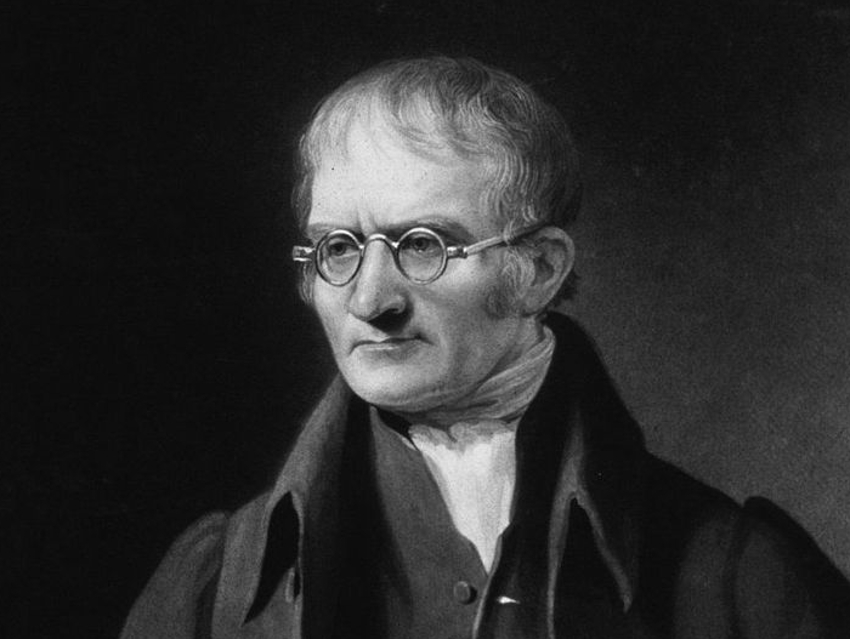John Dalton was born on September 6, 1766, in Eaglesfield, UK. His family was modest and a part of the Quaker movement. He was educated by his father and at a Quaker private school. Dalton taught at the village school starting at age 12, then at a boarding school run by Quakers, and later in Manchester, UK. There, he joined the Manchester Literary and Philosophical Society, which provided him with laboratory facilities.
Dalton’s early research dealt with color blindness, which he suffered from. A certain form of color blindness, deuteranopia, is still called “Daltonism” today. He also worked in the field of meteorology and kept daily weather records for most of his life. He published an important book on the topic called Meteorological Observations and Essays [1]. His meteorological work led him to research the properties of gases. He formulated Dalton’s law in 1801 (published in 1802): In a mixture of non-reacting gases, the total pressure exerted is equal to the sum of the partial pressures of the individual gases [2].
Dalton’s most well-known contribution to chemistry is his pioneering work on modern atomic theory. He stated that
- each chemical element is composed of identical atoms,
- that atoms of different elements have different properties,
- that atoms cannot be altered or destroyed by chemical means, but can combine to form compounds at defined ratios,
- and that during chemical reactions, atoms are rearranged.
While the concept of the atom goes back to ancient Greece, Dalton provided the first description of the atom as a chemical building block in the modern sense. He also provided a method of calculating relative atomic weights for the chemical elements. He published these theories in A New System of Chemical Philosophy [3]. The modern atomic theory was not universally believed at first, but its usefulness in explaining chemical observations led to its acceptance growing slowly over time. It is mostly correct, but had to be amended to account for the existence of subatomic particles and different isotopes of an element. The unit of atomic mass is named Dalton (Da) in his honor.
The Irish chemist William Higgins claimed to have developed the principles of the atomic theory before John Dalton. While many historians rule out that Dalton built directly on William Higgins’ insights, Mark I. Grossman published a paper in 2014 that claims both of them may have been influenced by the work of Bryan Higgins, William Higgins’ uncle [4].
John Dalton suffered several strokes in the last years of his life, which progressively limited his ability to perform research. He died on July 27, 1844, in Manchester.
John Dalton is the answer to Guess the Chemist (91).
References
- [1] Meteorological Observations and Essays,
John Dalton,
W. Richardson, J. Phillips, W. Pennington, London, UK, 1793. - [2] Essay IV. On the expansion of elastic fluids by heat,
John Dalton,
Mem. Lit. Philos. Soc. Manch. 1802, 5, 595–602. - [3] A New System of Chemical Philosophy,
John Dalton,
R. Bickerstaff, London, UK, 1808. - [4] John Dalton and the London atomists: William and Bryan Higgins, William Austin, and new Daltonian doubts about the origin of the atomic theory,
Mark I. Grossman,
Notes. Rec. R. Soc. Lond. 2014, 68, 339–356.
https://doi.org/10.1098/rsnr.2014.0025
Sources
- John Dalton,
Science History Institute,
www.sciencehistory.org.
(accessed July 1, 2019) - John Dalton and the Scientific Method,
Mark Michalovic,
Science History Institute, May 22, 2008.
www.sciencehistory.org.
(accessed July 1, 2019)



